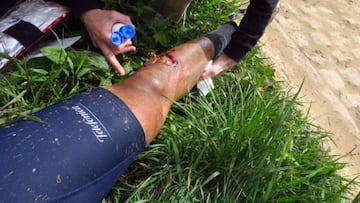Disc brake injury slices Ventoso's leg open on Paris-Roubaix
The Movistar cyclist denounced the use of the brakes after the injury that saw him require surgery to the wound on his leg caused by a disc brake.

Disc brakes are the hot, dangerous, topic in pro cycling right now. The sport’s governing body has permitted them in certain circumstances since the end of 2015, but controversy continues to swirl in the peloton over the damage the lethally sharp discs can do in an accident.
Last Sunday, on the classic Paris-Roubaix course Spanish rider Fran Ventoso was involved in one of the many crashes along the route and couldn’t continue after a disc brake sliced his leg open - he needed surgery to repair the wound.
The Movistar cyclist has since written an open letter denouncing the brakes and explaining the aftermath of his fall: “I looked at my leg: it wasn’t sore, there wasn’t too much blood, but I could see part of the periosteum - I could see the membrane covering my tibia. I went off to the right, I threw myself on the grass, I put my hands on my face and I started to feel dizzy… “ The disc had sliced him open.
The UCI, cycling’s governing body, approved the use of disc brakes for August and September of 2015 and in 2016 they can be used on an experimental basis - with the possibility of bringing them in definitively in 2017. Two teams used them on the Paris-Roubaix, Lampre and Direct Energie. 16 cyclists, 32 discs. “15 kilometres later Nikolas Maes had to be taken away in an ambulance with a gash on his knee. What will happen when there are 396 discs in a race with 198 cyclists fighting for position, with inevitable falls", continued Ventoso in his letter.
Related stories
The Movistar sprinter went on: “The discs should never have been allowed in the professional peloton, at least not as we know them now. Not before they have protection and safety systems to avoid them becoming actual knives installed on the bikes. They are knives, and at certain speeds they become machetes. There are races where we’re going 80, 90 or even 100 km/h. I’ve been lucky, it’s just a leg, just muscle and skin. Can you imagine a disc in the jugular, in the femoral artery? No, better not to think about it”.
Other cyclists, such as Purito, have demanded the discs be covered, and the Professional Cyclists Association have asked the UCI to suspend their use for the time being. Will the brakes be slammed on the discs?
#ParisRoubaix freins à disque prêts à rouler sur les pavés ☑ pic.twitter.com/uD3wfeGQ5g
— Team TotalEnergies (@TeamTotalEnrg) April 10, 2016
